Why this resume works
- Quantifies accomplishments: Measurable accomplishments like reducing engine downtime by 30% and improving fuel efficiency by 15% highlight the applicant’s impact.
- Highlights industry-specific skills: Specialized skills in diesel engine diagnostics and hydraulic systems show the applicant’s fit for roles demanding technical expertise in automotive mechanics.
- Illustrates problem-solving ability: Implementing maintenance protocols that reduced breakdowns by 25% annually illustrates innovative problem-solving skills and proactive fleet management.
More Diesel Mechanic Resume Examples
See our diesel mechanic resume examples to learn how to showcase your repair skills, technical expertise, and problem-solving abilities. These mechanics resume samples will help you create a resume that captures industry expectations effectively.
Entry-Level Diesel Mechanic
Why this resume works
- Centers on academic background: By showcasing a Master of Engineering in automotive engineering in the education section, the applicant shows a solid academic foundation, important for early career success.
- Puts skills at the forefront: Placing skills prominently at the top aligns with a skills-based resume format, effectively highlighting abilities like precision diagnostics and engine rebuilding.
- Shows digital literacy: Using technical documentation and safety compliance as key skills reflects the applicant’s digital readiness, aligning with essential computer skills for modern workplaces.
Mid-Level Diesel Mechanic
Why this resume works
- Points to measurable outcomes: By referencing achievements like cutting repair times by 20% and costs by $5,000 monthly, the applicant effectively showcases their ability to drive measurable improvements.
- Displays technical expertise: Showcasing skills like diesel engine repair and certifications such as ASE Master Technician highlights a solid foundation of technical expertise, important for mechanical roles.
- Includes a mix of soft and hard skills: Combining technical troubleshooting with team leadership and interpersonal skills, the applicant presents a well-rounded skill set essential for effective workplace collaboration.
Experienced Diesel Mechanic
Why this resume works
- Focuses on work history: Using a chronological resume format, the applicant highlights extensive career experience in diesel mechanics and fleet management across multiple roles.
- Showcases impressive accomplishments: By quantifying achievements like reducing engine failures by 20% annually, the applicant reflects significant business impact.
- Emphasizes leadership skills: Training apprentices and boosting team productivity are examples of how the applicant emphasizes strong leadership skills throughout their career.
Diesel Mechanic Resume Template (Text Version)
Emily Lee
Crestwood, KY 40021
(555)555-5555
Emily.Lee@example.com
Professional Summary
Experienced diesel mechanic with expert skills in engine diagnostics, repair, and maintenance. Proven track record in enhancing vehicle efficiency and reducing downtime. Strong problem-solving abilities and commitment to quality service.
Work History
Diesel Mechanic
Greenfield Transport Services – Crestwood, KY
February 2023 – August 2025
- Diagnosed and repaired diesel engines
- Reduced engine downtime by 30%
- Improved fuel efficiency by 15%
Automotive Technician
Midwest Car Care – Crestwood, KY
February 2021 – January 2023
- Serviced over 400 vehicle engines annually
- Increased client satisfaction by 20%
- Implemented new maintenance protocols
Heavy Equipment Mechanic
Northern Industries Equipment – Louisville, KY
February 2019 – January 2021
- Maintained fleet of 50+ heavy vehicles
- Reduced breakdowns by 25% annually
- Trained 5 junior mechanics
Skills
- Diesel Engine Diagnostics
- Mechanical Repair
- Preventive Maintenance
- Hydraulic Systems
- Electrical Troubleshooting
- Customer Service
- Technical Documentation
- Engine Rebuilding
Education
Bachelor’s Mechanical Engineering
University of Illinois Champaign, Illinois
May 2019
High School Diploma General Studies
Springfield High School Springfield, Illinois
June 2015
Certifications
- Certified Diesel Mechanic – National Institute for Automotive Service Excellence
- Advanced Engine Performance Specialist – Institute of Automotive Technicians
Languages
- Spanish – Beginner (A1)
- German – Beginner (A1)
- French – Beginner (A1)
Related Resume Guides
Advice for Writing Your Diesel Mechanic Resume
Dive into our tailored advice on how to write a resume for a diesel mechanic position and discover ways to make your technical abilities and hands-on experience stand out from the crowd.
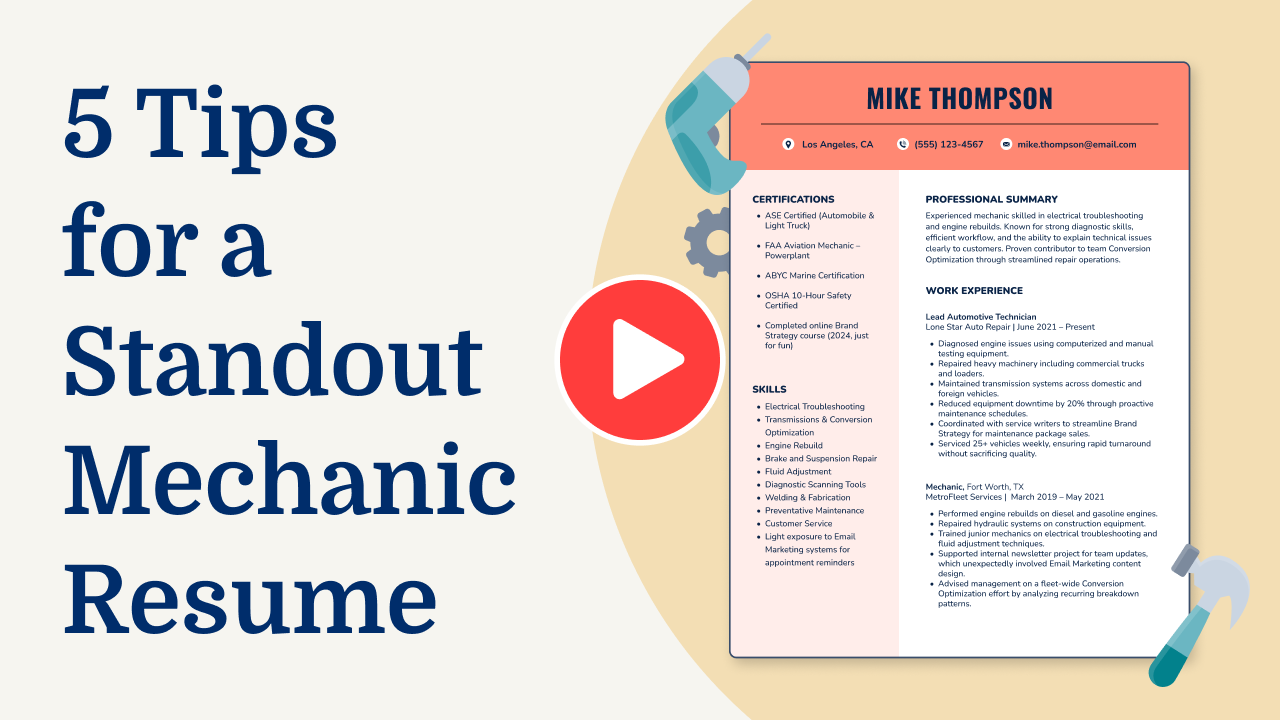
Highlight relevant technical skills
Highlighting technical skills is important for a diesel mechanic’s resume, as they form the backbone of the role. Consider creating a dedicated skills section or integrating these abilities into your work experience entries to help employers quickly identify how you meet job requirements.
Specify the tools, techniques, and systems you’re familiar with to demonstrate your hands-on knowledge in maintaining and repairing diesel engines. For a diesel mechanic, essential skills include diagnosing engine issues with diagnostic equipment, performing preventative maintenance, and repairing components like fuel systems, transmissions, brakes, and hydraulics.
Employers also value experience with specialized tools such as torque wrenches and pneumatic systems. Make sure to mention any familiarity with engine management systems or software like Cummins INSITE or CAT ET that assist in troubleshooting.
Don’t overlook practical abilities like reading technical manuals and blueprints or adhering to safety standards. If you’ve worked on heavy machinery or different types of diesel equipment—such as buses, trucks, or generators—be sure to specify that too. Detailing these aspects shows you have both the skillset and adaptability needed for this hands-on role.
Example of a technical skills section
- Diesel engine diagnostics and repair
- Hydraulic systems troubleshooting
- Electrical systems maintenance
- Fuel system management
- Brake and transmission service
- Air conditioning and heating systems
- Preventive maintenance procedures
- Engine overhauls and rebuilds
- Welding and fabrication techniques
- Use of diagnostic tools (multimeters, scan tools)
- Knowledge of safety regulations
You can use our Resume Builder to craft a resume that highlights technical skills in addition to key soft skills like teamwork, communication, and adaptability.
Quantify your accomplishments
Quantifying accomplishments on your resume makes it more compelling by showing the real impact of your work, rather than just listing duties. In the work experience section, each job entry should include your job title, employer name, location, and employment dates.
As a diesel mechanic, instead of saying you “repaired engines,” describe how you “reduced engine downtime by 30% through efficient repairs.” This shows not only what you did but how well you did it.
Turning duties into achievements with measurable outcomes like percentages or time savings makes your resume stand out. For example, if you improved fuel efficiency in fleet vehicles, say “increased fleet fuel efficiency by 15%.” Using action verbs and metrics creates a results-driven resume that highlights your skills and impact clearly.
Quantified accomplishments help hiring managers quickly see what you’ve achieved as a diesel mechanic and predict how you’ll perform in their company. This approach not only showcases your abilities but also makes it easy for employers to understand the value you’d bring to their team.
5 diesel mechanic work history bullet points
- Performed diagnostics and troubleshooting on diesel engines, reducing downtime by 30%
- Conducted regular maintenance checks, extending engine life by 20%
- Repaired and replaced faulty components, improving vehicle performance by 25%
- Trained junior mechanics on best practices, improving team efficiency by 15%
- Managed inventory of parts and tools, ensuring availability and reducing costs by 10%
Get inspired and build your best resume by checking out these professional resume examples. They make it easy to see what works for different jobs.
Write a powerful professional summary
A professional summary on a resume serves as an introduction for hiring managers, providing a snapshot of your skills and accomplishments. You can decide whether to use a summary or a resume objective based on your experience level and career goals.
A professional summary is best for those with some work experience. It’s three to four sentences long and highlights skills, experiences, and achievements, showing who you are professionally and what value you bring to the job. If you’re an experienced diesel mechanic, use this section to showcase your work history and success stories.
On the other hand, a resume objective focuses on future goals. It’s more about career aspirations and suits entry-level workers, those changing careers, or individuals with resume gaps better. Think of it as “what I’ve accomplished” versus “what I aim to contribute.”
Next, we’ll explore examples of both summaries and objectives for different jobs and levels of experience, helping guide you in crafting your own statements effectively.
Diesel mechanic resume summary examples
Entry-level
Recent graduate with an associate degree in diesel technology from a NATEF-accredited program. Certified in ASE Diesel Engines and eager to apply foundational skills in engine diagnostics, basic repairs, and preventive maintenance. Familiar with diesel systems and tools, committed to starting a career focused on safety and efficiency within the industry.
Mid-career
Seasoned diesel mechanic with over seven years of experience specializing in heavy trucks and construction equipment. Expertise in troubleshooting complex mechanical issues, performing routine inspections, and executing detailed repair plans. Holder of multiple ASE certificat,ions including Medium/Heavy Truck Technician. Recognized for improving fleet uptime through efficient service delivery.
Experienced
Veteran diesel mechanic with more than 15 years of experience leading teams in large-scale maintenance operations for commercial fleets. Specializes in advanced diagnostics, emissions control systems, and hydraulic systems repair. Proven track record of implementing process improvements that reduce downtime by 20%. Dedicated to mentoring junior technicians and fostering a culture of continuous learning.
Diesel mechanic resume objective examples
Recent graduate
Eager and detail-oriented recent graduate with a diploma in diesel technology, seeking an entry-level position as a diesel mechanic. Excited to apply hands-on training and knowledge of engine repair, maintenance, and diagnostics in a fast-paced automotive environment.
Career changer
Dedicated professional transitioning from construction to diesel mechanics, bringing strong mechanical aptitude and problem-solving skills. Looking to contribute to a skilled team by applying knowledge of heavy equipment maintenance and repair learned through technical courses and practical experience.
Specialized training
Ambitious individual with specialized training in diesel engine systems, eager to start a career as a diesel mechanic. Committed to using expertise in troubleshooting and preventive maintenance techniques to ensure vehicle safety and reliability in a supportive workshop setting.
Choose a resume template with clear headings and simple fonts. Avoid busy designs or bright colors that distract from showcasing your skills, experience, and work achievements.
Showcase your credentials
In the role of a diesel mechanic, having the right certifications can show your skills and knowledge in handling complex machinery. These credentials show that you have been trained and know what you’re doing, which makes employers trust you more.
Listing your certifications clearly on your resume helps you stand out from others who might not have the same specialized training. Creating a dedicated certifications section is a smart move to highlight these achievements alongside your education. Here are a few examples of relevant certifications:
- ASE Certified Diesel Mechanic
- EPA 609 Certification
- Certified Commercial Vehicle Inspector
- OSHA Safety Certificate
- Cummins Engine Certification
By showcasing these certifications, potential employers can see that you are ready to tackle the challenges of being a diesel mechanic. They help prove your ability to maintain and repair diesel engines effectively. This makes it easier for hiring managers to choose you for their team.
Example of a certifications section
ASE Diesel Engine Certification
Issued by: National Institute for Automotive Service Excellence (ASE)
Expires 2025
Heavy Duty Truck Systems Certification
Issued by: Universal Technical Institute (UTI)
Issued 2022
Hydraulic Systems Specialist Certification
Issued by: Association of Equipment Manufacturers (AEM)
Expires 2024
Brake Systems Technician Certification
Issued by: Automotive Training Institute (ATI)
Issued 2021
Air Conditioning and Refrigeration Technician License
Issued by: Environmental Protection Agency (EPA)
Expires 2026
Use a polished and professional resume format that aligns with your experience level to ensure your skills and qualifications stand out to hiring managers.
FAQ
Do I need to include a cover letter with my diesel mechanic resume?
Yes, including a cover letter with your diesel mechanic resume can improve your application and show you’re genuinely interested in the role. A cover letter provides an opportunity to highlight specific skills or experiences, like troubleshooting engine problems or working on heavy-duty vehicles, making you a strong applicant for the job.
If the company specializes in certain machinery or has unique service requirements, mentioning your expertise or interest in those areas can make your application more appealing.
To easily craft a personalized cover letter, try using our Cover Letter Generator for tailored guidance based on your resume details and career goals. You might also find it helpful to look at some cover letter examples relevant to mechanics and technical roles for inspiration.
How long should a diesel mechanic’s resume be?
For a diesel mechanic, the length of your resume depends on your experience. If you’re newer to the field or have fewer roles under your belt, a one-page resume is perfect for focusing on key skills like engine repair, diagnostics, and relevant certifications. Keep it concise while showcasing what makes you stand out.
On the other hand, if you’ve worked in several positions or have specialized expertise, like working with specific diesel systems, a two-page resume might be more appropriate. Include only the most relevant details to keep it engaging.
If you’re still unsure how long a resume should be, consider factors like career stage and relevance of your experience to decide which format works best.
How do you write a diesel mechanic resume with no experience?
When crafting a diesel mechanic resume with no experience, focus on highlighting your skills, training, and enthusiasm for the automotive industry. Here are a few ways to create an impressive entry-level resume:
- Highlight relevant education: Start with your educational background, especially if you’ve completed courses in diesel technology or automotive repair. Include the institution’s name, your graduation date, and any honors or relevant coursework.
- Include certifications and training: List any certifications, like ASE (Automotive Service Excellence), that you have obtained, as they are valuable even without work experience.
- Showcase hands-on projects: Mention any personal or school projects where you’ve worked on diesel engines or vehicles. Describe what you did and the skills you gained.
- Emphasize soft skills: Diesel mechanics need problem-solving abilities, attention to detail, and teamwork skills. Highlight these in your resume to show you’re ready for the role.
See our guide on writing a resume with no experience for more detailed advice on crafting a resume specifically tailored to entry-level diesel mechanic positions.
Rate this article
Diesel Mechanic
Additional Resources
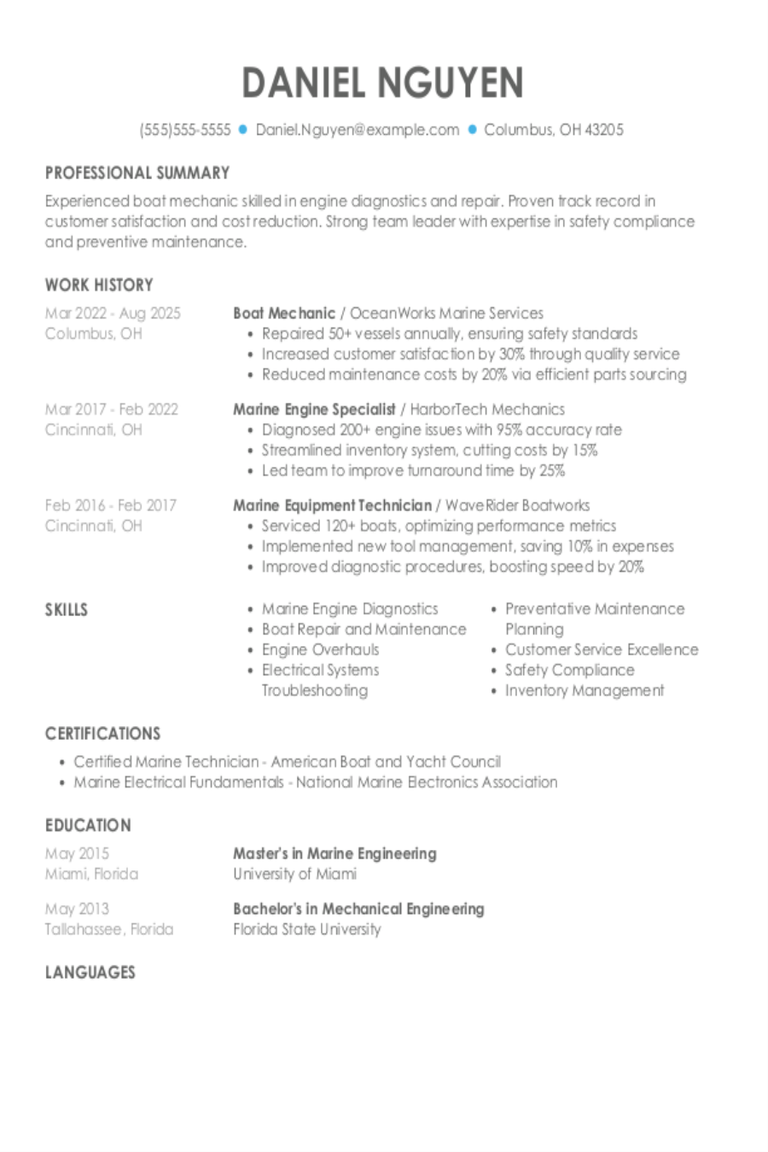
Boat Mechanic Resume Examples & Templates for 2025
Explore boat mechanic resume examples to see how to highlight experience fixing engines, diagnosing problems, and doing regular maintenance. Discover tips to showcase your skills in keeping boats running smoothly
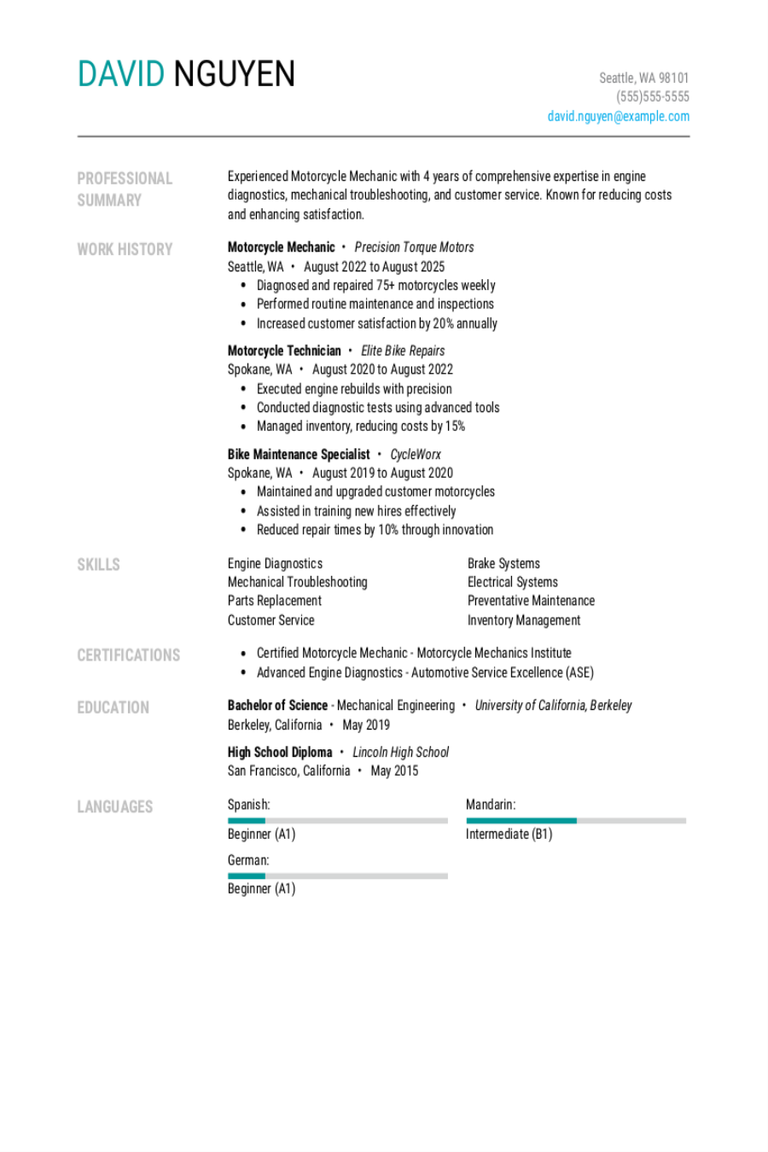
Motorcycle Mechanic Resume Examples & Templates for 2025
Discover how motorcycle mechanics can showcase their skills in fixing engines and maintaining bikes. These examples and tips will help you spotlight your hands-on experience and love for motorcycles to
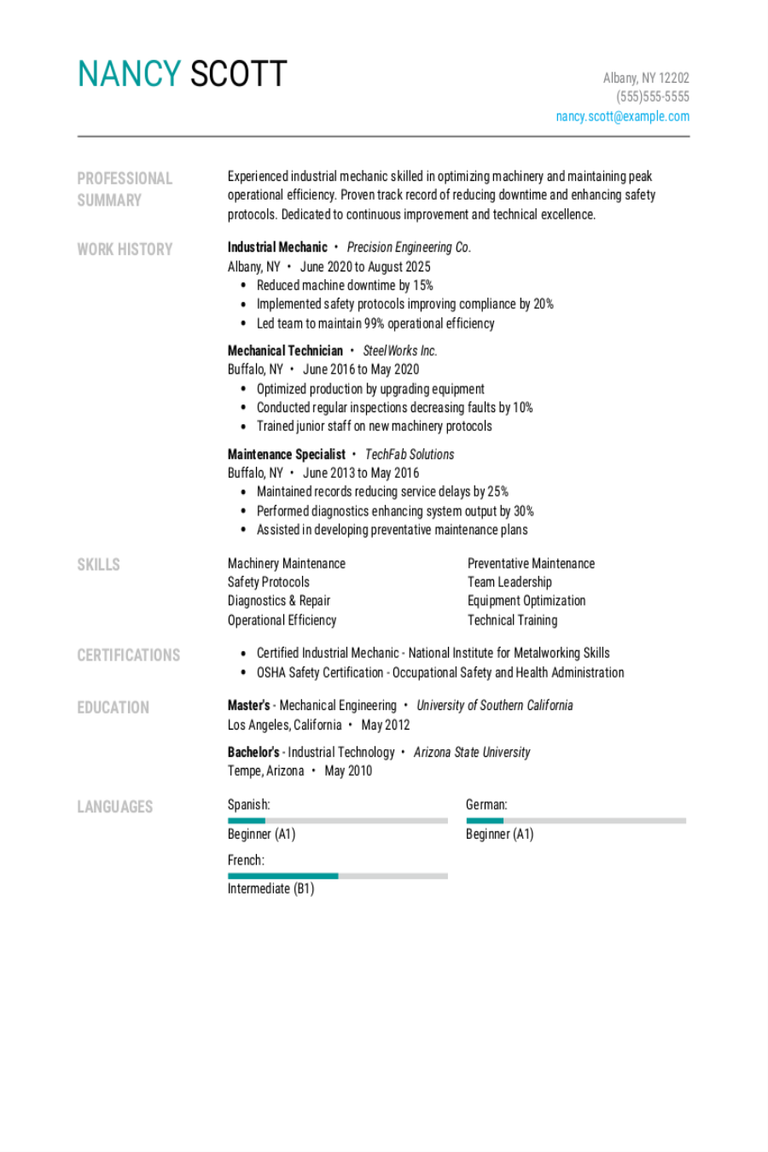
Industrial Mechanic Resume Examples & Templates for 2025
Explore how industrial mechanics highlight fixing machines and keeping equipment running smoothly on their resume. These examples and tips show you how to make your skills and experience shine on
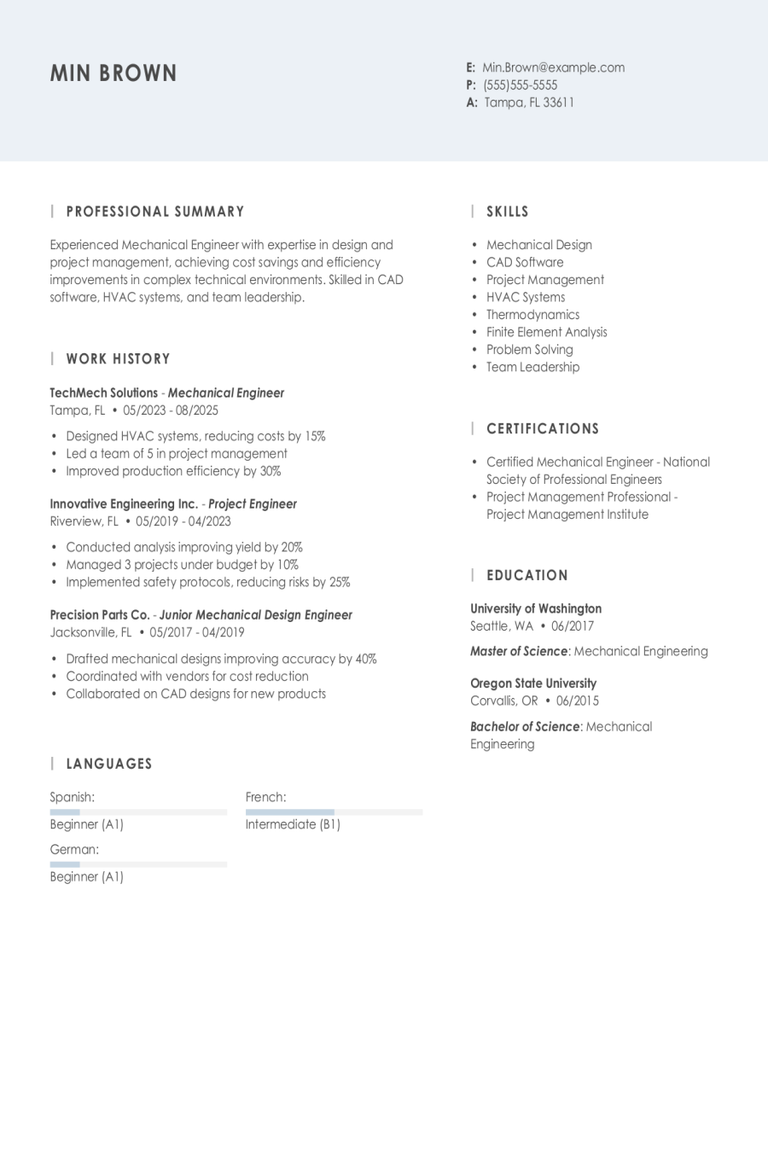
Mechanical Engineering Resume Examples & Templates for 2025
Explore mechanical engineering resume examples that show you how to highlight design skills, problem-solving abilities, and experience with machines. Learn to showcase your role in creating efficient systems and improving
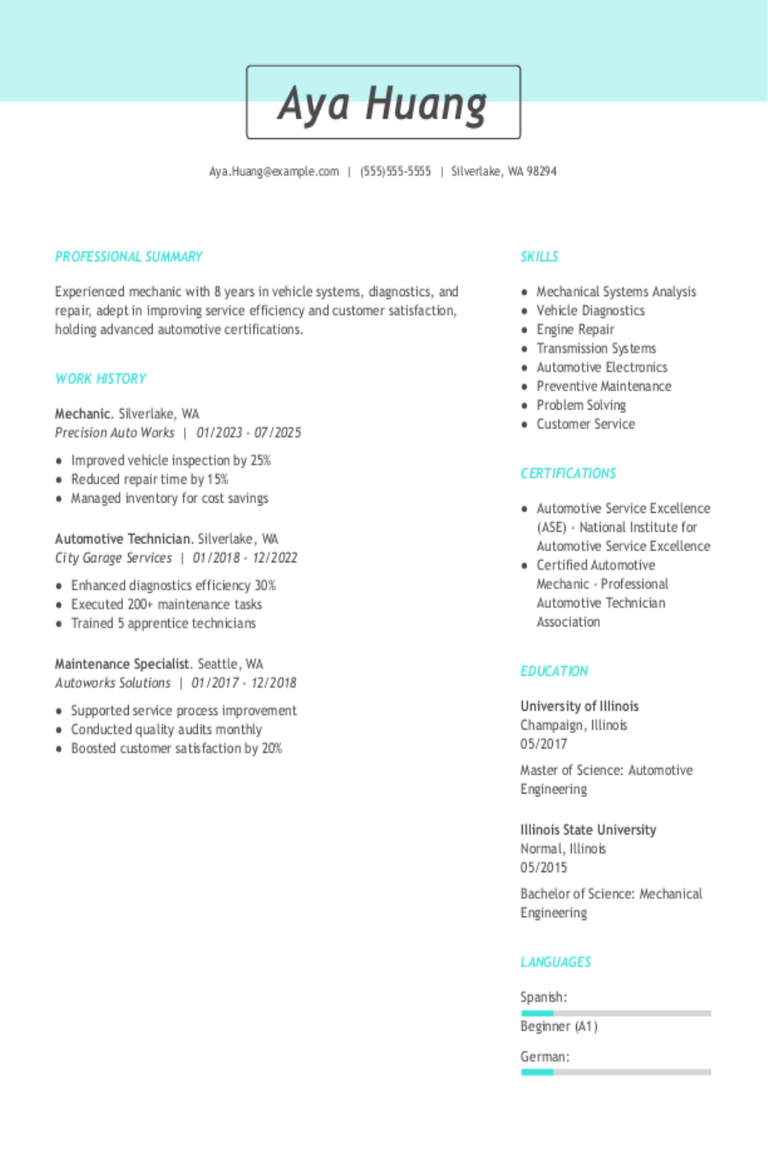
Mechanics Resume Examples & Templates for 2025
Discover mechanic resume examples to see how to showcase your hands-on skills and repair experience. Learn how to highlight your expertise in fixing vehicles and impress auto shops looking for
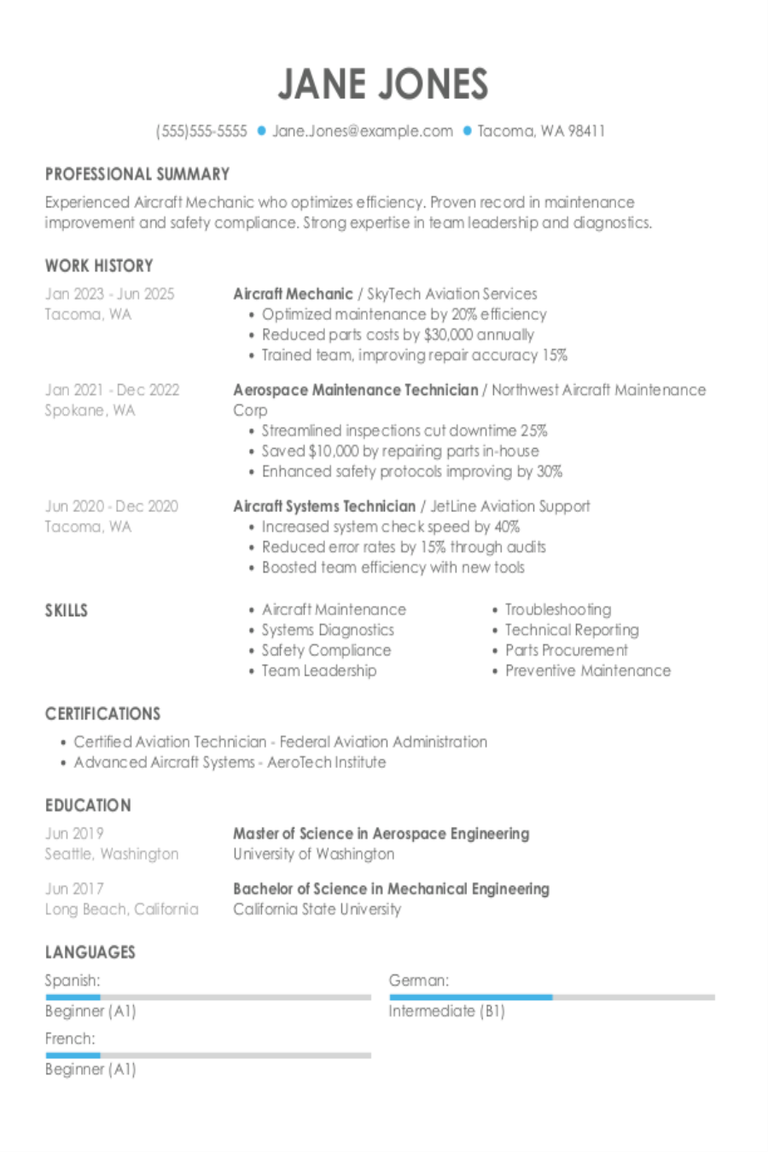
Aircraft Mechanic Resume Examples & Templates for 2025
Explore aircraft mechanic resume examples that highlight experience fixing and maintaining airplanes safely. Get tips for showcasing your repair skills and relevant experience.Build my resumeImport existing resumeCustomize this templateWhy this
